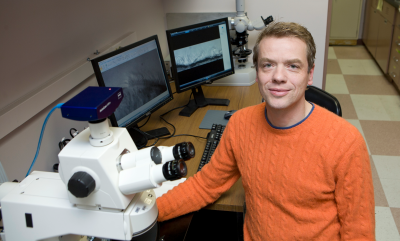Microscopes and movie cameras: Celldance celebrates the art that underlies the work

Though he’s never been to Hollywood, Karl F. Lechtreck, PhD, research assistant professor of cell biology, is now a famous movie maker—at least among his fellow cell biologists. Lechtreck shared second place in the American Society for Cell Biology’s (ASCB) annual Celldance, a video and photo contest that focuses on “the art that underlies the work cell biologists do every day.”
A good-natured spoof of the well-known Sundance Film Festival, which captures the attention of movie makers and movie lovers every January, Celldance celebrates the unexpected and unique beauty and art found under the microscope by cell biologists and seeks to “open the eyes of the world to the best video and still images that illuminate the wonders of cell biology.” Some of the publicity and chatter behind Celldance is tongue-in-cheek and riddled with science jokes (each year the posters calling for entries focus on a Hollywood theme but add a science twist: This year it was “Brokeback Mitochondria: True Tales of the Wild, Wild Western Blot”). But the winning photos and videos themselves are, according to the ASCB, “visually engaging and scientifically important.” Unveiled at the annual meeting of the ASCB in Philadelphia, the winners are eye catching and capture a moment of beauty in biology.
Although less than 10 seconds long, Lechtreck’s videos—“Motion of Ependymal Cilia” and “Ciliary Motility in the Mouse Airway Epithelium”—are as mesmerizing to the lay viewer as they are illuminating to the cell biologist. Lechtreck and his colleague George B. Witman, PhD, the George F. Booth Chair in the Basic Sciences and professor of cell biology, are studying the motion of cilia. Defects in ciliary motion result in primary ciliary dyskinesia (PCD), an inherited disease that causes patients to suffer chronic airway infections due to an inability to clear fluid, bacteria and debris. They have found that, in animal models, an impairment of ciliary motion also results in hydrocephalus, an accumulation of fluid within the cranium, suggesting that the beating of cilia is required to ensure proper fluid flow through the brain’s ventricular system, as it is for clearing the airways. Seeking to observe the motion of cilia in both environs, the researchers collaborated with Michael Sanderson, PhD, professor of physiology, who has built a differential interference contrast (DIC) microscope capable of filming at 200 frames per second. When slowed to 10 frames per second, the videos show the cilia bending and waving in a beautifully coordinated slow-motion dance.
“The cilia beat so fast it’s very difficult to see if they’re moving normally or not,” said Lechtreck. “But when we slow down the film, we see the distinct waving motion. In the dysfunctional model [with PCD] the movement is abnormal and as a result, there is no fluid flow.”
Lechtreck’s award-winning video will be archived in an online public library being built by the ASCB to preserve interesting videos and photos submitted by cell biologists. Celldance itself was dreamed up and spearheaded by Greenfield “Kip” Sluder, PhD, professor of cell biology, who served on the Public Information Committee for ASCB, as a way to help generate interest and accumulate material for the library.
“The library was created as a resource for teaching and public outreach,” Dr. Sluder said. “For example, if you’re teaching a lecture on cell division and you want some actual footage, you could download something useful and eye catching from the library.” Initially, interest was slow to build and, despite the lure of having their work forever archived in the library, members did not respond overwhelmingly when simply asked to submit their footage for the greater good.
In 2004, Sluder suggested the ASCB run a contest, complete with prize money and lots of promotional hype among the cell biology community, and was given the green light (not to mention the task) to create and oversee the contest. As contest director and head judge, Sluder acted as emcee and awarded the inaugural prizes in a fun and cheeky ceremony at the 2005 annual meeting. This year, he said, there was a crowd of more than 300 people at the ceremony, where prizes were awarded for first, second and third place, as well as honorable mention. (In addition, there is a category for public outreach that honors videos aimed at educating non-scientists.) Such a large crowd was gratifying, particularly because this year marked the end of Sluder’s term as contest director and head judge. His Celldance legacy remains captured in the ASCB image library, which will continue to grow with each contest.